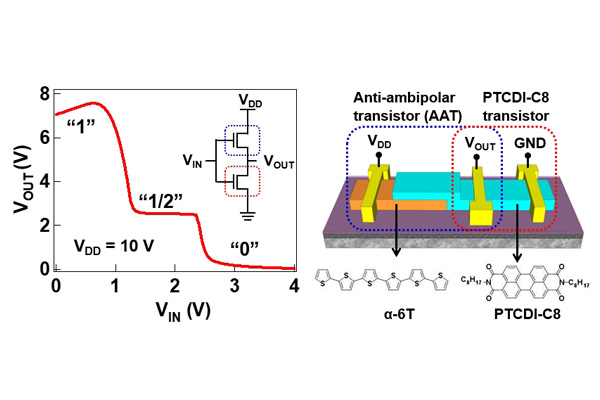- ホーム
- > 研究活動
- > Research Highlights
- > Vol. 42 Flexible Organic Electronic De・・・
 Research Highlights
Research Highlights
[Vol. 42]
Flexible Organic Electronic Devices for Three-Valued Logic Circuitry

Wearable and flexible integrated-circuit technology is on the rise, especially in the context of the ‘internet of things (IoT)’ — devices sharing information through the internet. So-called organic field-effect transistors (OFETs), built from organic molecules, are mechanically flexible, and therefore suitable for IoT electronics. OFETs are difficult to downsize, however, making their high-density integration onto flexible chips is problematic. Yutaka Wakayama at the International Center for Materials Nanoarchitectonics, National Institute for Materials Science, Tsukuba, Japan, and colleagues have now presented an alternative approach. Rather than considering OFETs offering conventional two-valued logic — with zeroes and ones — they developed a circuit element, built from organic materials, capable of handling three logical values.
Multi-valued logic circuits can process more data with a lower integration density than binary circuits. This notion inspired Wakayama and colleagues to build a ternary inverter from organic materials. (In three-valued logic, where an input signal can assume the values 0, 1/2 or 1, a ternary inverter converts these into 1, 1/2 and 0 output values, respectively — similar to the NOT gate in binary logic.)
The scientists’ inverter consists of two parts: an OFET and an element called an anti-ambipolar transistor. Although the transfer characteristics for their device did indeed correspond to three-valued logic functionality, its intrinsic operating voltage of 60 V is unrealistic for actual applications. By including a 30-nm thick aluminium oxide (a material with a high dielectric constant) layer in the device substrate, the researchers could bring the voltage down to 10 V.
The anti-ambipolar transistor has the advantage that, by varying the channel length, the in- and output voltage ranges corresponding to 0, 1/2 and 1 signals can be tuned. Lower signal voltages are important as they imply reduced power consumption.
The researchers carried out their measurements at ambient conditions, at room temperature, and demonstrated stability and reproducibility of the operation of the device. Wakayama and colleagues conclude that their “organic ternary inverter has great potential as a key element of future flexible IoT devices”.
Reference
“Multi-Valued Logic Circuits Based on Organic Anti-ambipolar Transistors”
Kazuyoshi Kobashi, Ryoma Hayakawa, Toyohiro Chikyow, and Yutaka Wakayama
Journal : Nano Lett. 18, 4355-4359 (2018).
DOI : 10.1021/acs.nanolett.8b01357
Kazuyoshi Kobashi, Ryoma Hayakawa, Toyohiro Chikyow, and Yutaka Wakayama
Journal : Nano Lett. 18, 4355-4359 (2018).
DOI : 10.1021/acs.nanolett.8b01357
Affiliations
International Center for Materials Nanoarchitectonics (WPI-MANA), National Institute for Materials Science (NIMS), Namiki 1-1, Tsukuba, Ibaraki 305-0044, Japan
Contact information
ナノアーキテクトニクス材料研究センター (MANA)
〒305-0044 茨城県つくば市並木1-1
TEL: 029-860-4710
E-mail: mana-pr=ml.nims.go.jp([ = ] → [ @ ] )
TEL: 029-860-4710
E-mail: mana-pr=ml.nims.go.jp([ = ] → [ @ ] )

